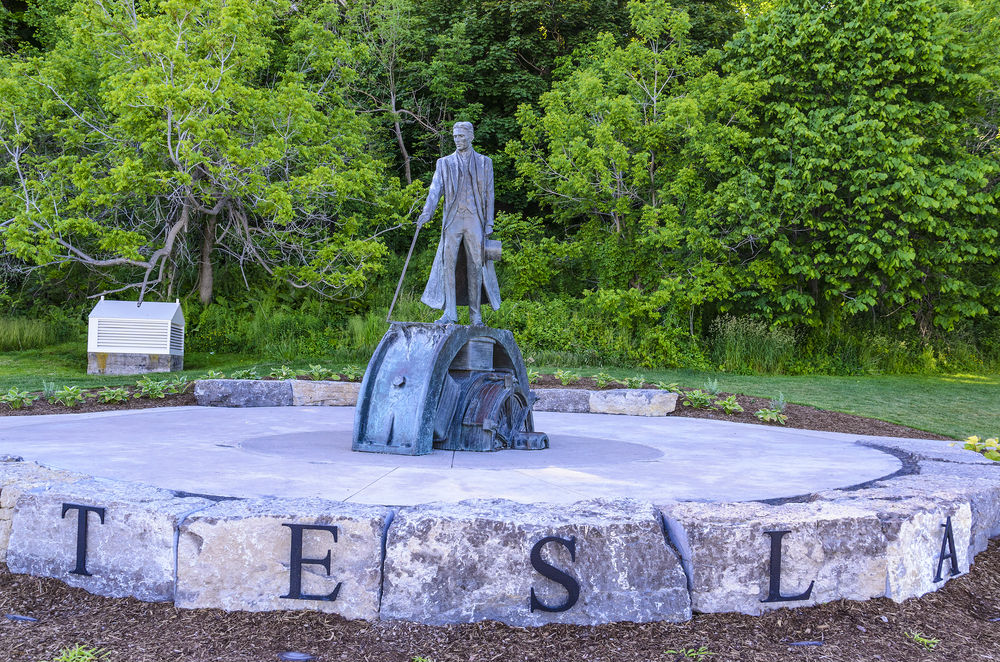
“I Don't Care That They Stole My Ideas - I Care That They Don't Have Any Of Their Own.” Nikola Tesla
He fell in love with a pigeon, had an extreme fear of germs, believed he had made contact with alien beings, and chose to serve humanity rather than feed his own ego.
Scientist Nikola Tesla – mysterious, eccentric and misunderstood – yet loving, and arguably the greatest mind that ever lived – developed alternating current to power the planet – but he didn’t work for fame or fortune. Tesla’s commitment to big ideas, making this a better world, provides a blueprint for how today we too can expand our careers while serving a worthy cause.
“I don’t care that they stole my ideas – I care that they don’t have any of their own.” Nikola Tesla
Other scientists of his day routinely took Tesla’s ideas. Among them – Marconi, credited with inventing radio (even though Tesla was the first to work on wireless power). But Tesla was never bitter. Referring to Marconi as a “good fellow,” Tesla wished Marconi the best of luck and urged him to carry on (even though Marconi had taken 17 of Tesla’s patents). Thomas Edison borrowed from Tesla too. But Tesla and Edison would come to respect one other. To Nikola Tesla, the important thing was always the end result, and not his own glorification. Today, it’s every person for themselves. But serving the common good, regardless of recognition, is essential if our planet is to advance. Be that rare star who promotes ideas in place of self-importance.
“Peace can only come as a natural consequence of universal enlightenment and merging of races, and we are still far from this blissful realization.” – Nikola Tesla
Working for a cause, not just money, provides us with a purpose. Tesla put his incredible mind to work for the benefit of everyone. He was perhaps the world’s first “techie” who could produce miracles (while ignoring the business side of things). Had Tesla been more concerned with the almighty dollar, we might all still be living in the dark. During his lifetime, he did well financially compared to most people of his day, but that success was a by-product of his high ideals. Put the focus on solutions. The money will follow.
“The present is theirs; the future, for which I really worked, is mine.” – Nikola Tesla
Most of us are so distracted by our daily struggles, we can barely think about tomorrow, let alone years from now. But those who work to improve the plight of humanity have a keen eye on the distant future. What we do now will dramatically affect future generations. It is perhaps our preoccupation with “self” that is the greatest danger to our children and grandchildren. Tesla worked for the future. Whatever work we do, let’s always consider the implications down the road.
Nikola Tesla started out in life with a bang. Born during a lightning storm in July of 1856, the midwife declared (according to family legend) that it was a bad omen and the tiny Tesla would live in darkness. Tesla’s mother is said to have responded, “Oh no. This means he will be a child of light!”
She was right. Tesla, would in fact, become the genius who would light up the planet.
He would also mature to acquire a wide range of strange behaviors, be scorned by other jealous inventors (originally labelled a “mad scientist” by Edison), die penniless and become largely forgotten today.
As a teenager, Tesla experienced a near-fatal bout of cholera, leading to a life-long fear of germs. Later as an adult, he demanded 18 clean towels a day. He trusted no-one to clean his surroundings, preferring to do his own dusting. (Cholera is a serious infection caused by consuming contaminated water or food and can kill within hours if untreated. It was widespread in the 1800s before modern sewage treatment).
His interest in electricity began in school watching demonstrations by his professors. He later recalled “I wanted to know more about this wonderful force.”
But Nikola Tesla was no ordinary student.
He could perform advanced calculus in his head, within seconds, causing his teachers to suspect he was cheating. At technical school in Austria he earned the highest grades possible, with the dean telling his father “Your son is a star.”
As early as he could remember, Tesla experienced a strange reaction when he engaged in deep breathing. According to Tesla researcher and author John J. O’Neill (in his book “The Prodigal Genius), Tesla would be overcome by a feeling of lightness as if “his body had lost all weight.”
This bizarre unexplained physical experience was somehow connected to Tesla’s ability to do advanced mathematics and see any object in his mind as three dimensional, judging dimensions to a hundredth of an inch.
As a result, Tesla had difficulty distinguishing between what was in his head and reality.
He could look at a blank blackboard and without touching a piece of chalk, envision a complex problem with a range of solutions written on it.
Tesla also had a photographic memory. Once he read something, he had a permanent record of it in his head – and not just the message of the text, but every word. He could create detailed blueprints of inventions entirely in his mind.
But how did he do it? Tesla left few clues, explaining himself this way:
“My method is different. I do not rush into actual work. When I get a new idea, I start at once building it up in my imagination, and make improvements and operate the device in my mind. When I have gone so far as to embody everything in my invention, every possible improvement I can think of, and when I see no fault anywhere, I put into concrete form the final product of my brain.”
Essentially, Tesla used visualization – seeing his inventions, first in his imagination, working out every detail in his mind’s eye – before putting anything to paper, or creating anything physical.

This incredible photo was taken in 1899 as a publicity shot for Tesla. The photo is an example of what today would be a “photoshopped” image – with the electrical arc having been taken separately, then enlarged and superimposed in the shot of Tesla sitting in his Colorado laboratory. Tesla himself was not keen on the photo, saying “I did not like this idea but some people find such photographs interesting.”
Despite being well-known in his life-time, Nikola Tesla was a loner. It is believed he died a virgin, having never married or even engaged in any romantic relationships. Yet, he was loving – if not towards a partner, then humanity as a whole, once saying “It’s not the love you make. It’s the love you give.”
Some historians have made the claim that Tesla was asexual. His aversion to intimacy may have been due to his extreme shyness. Others have speculated that Tesla had obsessive-compulsive disorder, making it difficult or impossible for him to have a relationship. He admitted to having “a violent response against the earrings of women” and for reasons unknown, he hated pearls.
Tesla himself said that a romantic relationship would have interfered with his work. While he appears to have had no relations with women, he could be considered a “feminist” sympathizing with the struggle of women toward gender equality. He once said that humanity would eventually be run by “Queen bees” and that women would be in control of the planet, necessary for our survival.
While humans were not his cup of tea, pigeons were. In fact, Tesla seems to have fallen in love with a white female pigeon. He went as far as to say he loved the bird “as a man loves a woman.” The pigeon apparently flew into his New York hotel window and became, what he called, the joy of his life. (The pigeon became ill and Tesla claims she died in his arms).

The year is 1896 and Nikola Tesla is 47 years old. He is pictured here at his New York lab sitting next to his high-voltage transformer.
Tesla, who claims to have never slept more than 2 hours a night (and could speak at least 8 languages), invented the first motor that was powered by alternating current (A.C.). He had other big ideas, developing A.C. generation and transmission. Much of his work allows us today to operate our computers and appliances, and light our homes and offices. (One report claims that Tesla once worked for 84 hours straight without rest).
Brilliant at creation, he was largely a failure as a business person.
In 1882, at the young age of 26, Tesla went to work for Thomas Edison at Edison’s facility in Paris (making $18 a week, or what is today, about $450). Tesla’s supervisor, saying he appeared to be as smart as Edison himself, recommended the young Tesla work for Edison in the United States.
But when Edison met Tesla, he was not impressed, saying Tesla’s ideas – including alternating current – were not practical. (Edison first favored direct current). The two disliked each other in the beginning, with Tesla complaining that Edison had poor hygiene.
Tesla left Edison to form his own company (reportedly the day Edison offered him a $10 a week raise, after Tesla had asked for $25). But without business skills, Tesla failed with his first venture, and for a period of time, was forced into a job digging ditches.
Tesla would then create another company, this time supported by entrepreneur George Westinghouse who also disliked Edison. But Tesla would end up selling his patents to Westinghouse for $1 million, and instead chose to work for Westinghouse (for what today would be $48,000 a month). It was Westinghouse who went on to create a power plant at Niagara Falls to supply alternating current to New York City using advice and information from Tesla. (Harnessing power from the falls had been Tesla’s dream from childhood).
Years later, after trying his best to discredit both A.C. and Tesla personally, Edison would admit that Tesla’s alternating current was more practical for large scale power, and he developed respect for Tesla.
It is said that Tesla never hated Edison, but he did criticize Edison’s method, which was to conduct many experiments to find solutions (leading to the legendary claim that Edison tried 10,000 times to develop the modern light bulb). The day after Edison died in 1931, Tesla – who did most of his experimentation in his mind – would write in the New York Times that had Edison simply used a little theory, calculation and brain power, it would have “…saved him ninety per cent of his labor.”

In April, 1894, writer Mark Twain is seen demonstrating the use of the human body to conduct electricity. The shadowy figure in the background is Tesla. The two met at a social club in New York City and became friends. (Tesla said reading Mark Twain’s books helped to boost his spirit as a child).
One of the strangest aspects to Nikola Tesla was his claim that he was in contact with alien beings. The claim stems from what today’s scientists say was simply the static generated by radio waves. Upon hearing the noise, Tesla surmised that he was listening to signals from deep space.
But today, a number of researchers are making the incredible claim that Tesla may have indeed made contact with aliens. According to Tesla biographer Tim Swartz, Tesla had been working on a powerful radio antenna and claims to have heard what sounded like “voices”. (This was before radio was used for commercial purposes).
At one point, Tesla created plans for his own flying saucer with the intent of visiting the aliens (which caused other scientists to believe Tesla was losing his mind).

An aging Nikola Tesla, unrecognizable from his younger years as a dashing inventor. This is believed to be the last photo taken of Tesla, likely a few weeks or months before his death in 1943. The genius with the computer brain lived to age 86, but the last 30 years of his life were spent mainly in seclusion.
In old age, Tesla became a recluse.
He died in room 3327 of his New York hotel. The body was discovered, surrounded by pigeons, by a maid who noticed a sign on the door that read “Do not disturb”. The official report has Tesla dying of a blood clot in his heart with no suspicious circumstances.
Almost immediately after he died, U.S. government officials went into the room and took all of Tesla’s private papers, most of which were handed over to the family, but some were retained – and are still held today by the U.S. government, categorized as “classified”.
Many believe that Tesla had been working on incredible inventions with the power to shock us even today. (We can only imagine why some of Tesla’s research remains locked away).
Serbian-American introvert Nikola Tesla was more of a humanist than an inventor or scientist. He believed strongly that his work belonged to humanity, not a corporation. His life serves as inspiration for anyone who believes in a higher purpose for work, and making this a better planet.
The man whose inventions became vital to modern life, died broke. Historians say that Nikola Tesla could have easily become the world’s first billionaire had he retained the royalties from his patents. Of the money he did make, none was saved or invested. Instead, Tesla spent it all on failed projects leading to bankruptcy. He was able to buy food and live through the generous help of his old friend George Westinghouse, who felt he owed Tesla since the Westinghouse company would likely never have survived without Tesla’s ideas and support. (Tesla said that George Westinghouse was the only person who believed in him).
Nikola Tesla is admired today by many hard working people around the world, who, like Tesla, never got the recognition they deserved.
Google founders Larry Page and Sergey Brin derived their inspiration from Tesla. Elon Musk, another admirer, named his car company “Tesla Motors”. Even Albert Einstein was a fan. It has long been rumored that when asked how it felt to be the smartest person on Earth, Einstein replied, “I wouldn’t know. Ask Nikola Tesla.” (But Tesla did not return the love, calling Einstein a “long haired crank”).
The City of Hamilton, Ontario was the first urban area in Canada to receive A.C. electricity and in honor of Tesla, named a major street after him (Nikola Tesla Boulevard) in 2016. (There is also “Tesla Street” on Long Island, New York where the Tesla Museum is located).
[This post by Cory Galbraith first appeared on LinkedIn and has been reproduced with permission.]






























 Ad-lite browsing experience
Ad-lite browsing experience